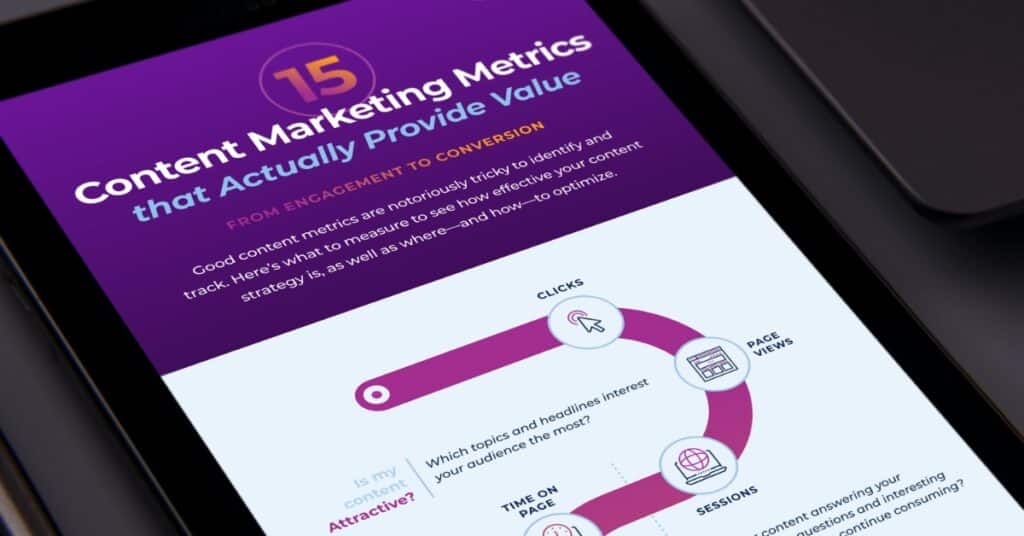Your boss calls you into their (probably virtual) office. That’s scary. Then they say, “show me how your content is driving conversions.” That’s downright terrifying. For a content marketer, that request is almost as stomach-dropping as that time HubSpot published the headline “Are your press releases been keeping up?”
Honestly, it’s hard to identify and track the kinds of content marketing metrics that indicate conversion. That’s because content marketing plays a much longer, more indirect role in influencing decisions. It influences them! But not the same way a sales nurture or ad does, where ROI can be gauged through an immediate action, such as a sign-up or sale.
Content marketing builds trust, establishes brand authority, and nurtures customer relationships over time. Which is why its impact can be more elusive and might not translate to immediate, tangible results. Content marketing influences the buyer across the entire journey—so you need metrics across the journey. Looking at your content performance from different angles can help you understand how well your content is achieving that.
So how do you measure it? How can you tell the story of your content performance to your boss?
Here are 15 content marketing metrics that will help you gauge how well your content is doing.
Scroll down for our analysis of each.
“But half of those are vanity metrics,” you say. The audience gasps.
First of all, we prefer to call them engagement metrics. And we don’t judge them. We just don’t depend on them alone. They tell a piece of the picture, but not the whole thing.
In a Coffee Break we hosted earlier this year, Ben Hoehn, VP of Marketing at Uberflip, brought up the challenge of evaluating the ROI of content marketing. The conversation hit home to us how many marketers look down on engagement metrics and give up too easily on conversion metrics. In the end, they’re both important to pay attention to.
Here’s what this spectrum of content marketing metrics tells you about your content.
We recommend paying attention across the spectrum to get the full picture of how your content is doing, as each group of metrics gives you important information about the impact your content has at each stage of the journey.
How attractive is your content?
Clicks, page views, and session count reveal audience interest in the topics and needs your content addresses. Clicks indicate the initial allure of content headlines and themes, suggesting what captures readers’ attention. Page views and number of sessions give you similar insights post-bounce—here you’re measuring who actually wants to see your content and stays on the page long enough to register a session.
If these numbers are consistently low, your brand awareness might be low. Either that or the topics you create content around aren’t resonating with your audience. If they’re low for specific pieces of content, then you know those specific topics or headlines aren’t hitting home. Alternatively, if some content pieces are getting a lot of clicks, especially related to a single topic, then you can reverse engineer what questions or pain points your audience needs answers for.
How interesting is your content?
Time on page, scroll depth, and watch time give you a good idea of whether your content is 1) interesting enough to keep consuming and 2) answering your audience’s questions. Time on page is tricky. How much of that time can you reasonably say is spent reading your content versus the time spent, I don’t know, making coffee or staring at the wall?
When combined with scroll depth or watch time, you get a clearer picture. A 30-minute long session? Must have been an interesting wall. 6 minutes? Could be coffee. A 6 minute long session where they scrolled to the bottom? They must have found that content valuable. On the flip side, if a lot of viewers are dropping off around the same point, that’s an indication of where you need to optimize.
How trustworthy is your content?
Pages per session, on-page click-through-rate (CTR), and return readers and viewers provide insights into whether you are successfully establishing your content platform as a go-to, trusted hub of information for your audience. It’s important to know if people are accessing your content and leaving versus consuming your content and then looking for more. That’s what pages per session tells you. Beware, though—a low pages per session number doesn’t necessarily mean your audience doesn’t want more. It could mean you’re not interlinking well or your website design doesn’t encourage browsing.
On-page CTR reflects the effectiveness of calls-to-action and internal links, indicating if your audience trusts the recommendations and suggestions provided within the content. Do you have a lot of return readers and viewers? It’s a good indication that you’re doing something right—viewers are starting to see you as a consistent source of valuable information. Don’t have a lot of returns? Your content probably needs a refresher to make sure it’s delivering value.
How worthwhile is your content?
Gated content opt-ins and newsletter subscriptions tell you how willing your audience is to exchange their personal information for access to exclusive content. We hope marketers grasp—and respect—just how much trust that implies.
It means your content is valuable enough that it’s worth getting into a nurture or on a salesperson’s radar. There are two potential insights here. Either your content is just that great or they trust you to not abuse their contact info. Remember what Uncle Ben once said, “With great power there must also come great responsibility.”
How influential is your content?
Contact us form fills, qualified leads, and the overall conversion rate work together to help you gauge how effectively your content is driving prospects towards a purchase decision. What makes these content marketing metrics different from the previous is how far apart they are from the content itself. A click or page view gives you direct insight into that particular piece of content. Here, you have to do some mapping to make the connection.
If you find that your current leads or conversions have previously consumed your content—especially if they’ve consumed a lot of it or even learned about you through your content—you can infer that your content had an influence on their journey and decision. On the other hand, if you have a lot of people engaging with your content and no leads, then you’re probably missing middle of the funnel or bottom of the funnel content.
If you have leads who have never engaged with your content previously, you could be missing out on an opportunity to accelerate the sales funnel, which brings us to the last category of content marketing metrics.
How impactful is your content marketing?
This is the longest game of all of them. As you optimize your strategy, improve your content, and fill out the whole journey with the right content, you should see the length of your sales cycle shorten. In addition to attracting leads, your content should ultimately help move prospects toward conversion.
It’s tricky to measure, but possible. Compare content touches for everyone on the buying team of your closed-won accounts to see if there’s a correlation between more content consumption and shorter sales cycles.
The Iron Horse insight.
There is no single metric that will tell them what they want to know. It’s a mosaic of metrics or nothing. And it’s not going to be fast. You can’t write a blog and host a webinar and expect that to turn into qualified leads tomorrow. Content marketing is an investment. It’s constant work and optimization cycles. But, combined with the right content strategy, it does work. And you can quote us to your boss on it.




